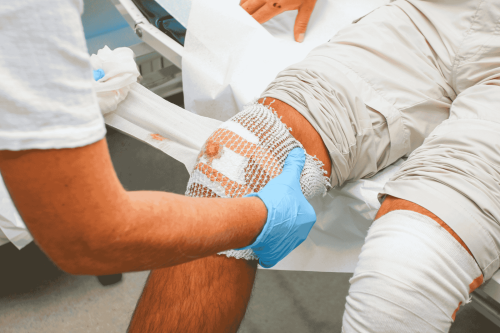When something goes seriously wrong in healthcare, the impact can be life-changing—for patients, families, and the professionals who dedicate their lives to providing care. These critical mistakes are often called sentinel events, and they serve as a wake-up call for organizations to look closely at their systems, processes, and training.
While sentinel events in healthcare are rare, the numbers show just how serious they can be. According to The Joint Commission, in 2023, falls made up 48% of all reported sentinel events, followed by wrong-site surgeries (8%) and retained foreign objects after surgery (8%). Each of these cases represents a preventable incident with the potential for devastating consequences.
That’s why preparation and prevention are so important. Training healthcare employees to recognize risks, respond effectively, and learn from these events is one of the most powerful ways to improve patient safety and protect staff. In this blog, we’ll explain what sentinel events are, why they matter, and how training helps prevent them.
What Are Sentinel Events in Healthcare?
The Joint Commission defines sentinel events in healthcare as unexpected occurrences that involve death, serious physical or psychological injury, or the risk of such outcomes. They’re called “sentinel” because they signal the need for immediate investigation and response.
Some common examples of sentinel events include:
- Wrong-site surgery (operating on the wrong patient or body part).
- Patient falls that lead to serious injury or death.
- Medication errors that result in severe harm.
- Delays in treatment that cause avoidable complications.
- Infections or retained objects after surgery.
- Elopement (a patient leaving a care setting unsupervised, leading to harm).
Each sentinel event is devastating, but each also represents an opportunity to learn and build safer systems.
Why Sentinel Events Matter
Sentinel events go beyond statistics—they impact human lives. They can mean serious injury, permanent disability, or worse, for patients. For providers, they can lead to stress, burnout, lawsuits, and loss of trust. For organizations, they can damage reputation, lower patient satisfaction, and increase costs.
The numbers highlight the urgency:
- Studies show that medical errors are a leading cause of death in the U.S., contributing to an estimated 250,000 deaths per year (Johns Hopkins, 2016).
- Patient falls are one of the most frequently reported sentinel events in healthcare, with thousands of cases reported to The Joint Commission annually.
- Wrong-site surgeries, though rare, still occur with alarming regularity and are considered completely preventable.
Behind each statistic is a patient who deserved better and a healthcare worker who wanted to do better. That’s why prevention—and especially training—is so vital.
How Training Helps Prevent Sentinel Events in Healthcare

Training healthcare employees is not just about compliance; it’s about empowering staff with the knowledge, awareness, and confidence to act before mistakes happen. Here’s how training makes a difference:
Raising Awareness of Risks
Many sentinel events occur because small warning signs are missed. Training teaches staff what to look out for, whether it’s a break in sterile technique, a mislabeled medication, or a patient at high risk for falls. Awareness is the first step in prevention.
Standardizing Procedures
Inconsistent processes create room for errors. Training reinforces standardized protocols, such as time-outs before surgery, double-checking medication doses, or fall risk assessments. Consistency across staff reduces the likelihood of mistakes slipping through.
Improving Communication
Miscommunication is a leading cause of sentinel events. Training emphasizes clear, structured communication tools like SBAR (Situation, Background, Assessment, Recommendation), so critical information is never lost between shifts, departments, or providers.
Simulating Real-Life Scenarios
Role-playing and simulation training give staff the chance to practice responses to high-risk situations in a safe environment. For example, a simulation might walk a team through how to prevent a wrong-site surgery or respond to a patient fall. Practice prepares staff to respond correctly under pressure.
Encouraging a Culture of Safety
Training helps shift mindsets from blame to learning. When staff feel comfortable reporting near-misses or potential hazards, organizations can address issues before they turn into sentinel events.
Reinforcing Compliance and Accountability
Training ensures staff understand regulations, policies, and their personal responsibilities. This strengthens accountability while ensuring compliance with standards from organizations like The Joint Commission.
The Role of Leadership in Training
Training is most effective when it’s supported from the top down. Leaders play a critical role in:
- Prioritizing safety by making sentinel event prevention a core value.
- Providing resources for regular, accessible, and engaging training.
- Encouraging reporting so staff feel safe speaking up about concerns.
- Leading by example to show that safety is everyone’s responsibility.
When leadership commits to training, staff are more likely to embrace it as part of daily practice.
Learning From Sentinel Events
Even with the best systems, sentinel events may still occur. What matters most is how organizations respond. Effective training helps teams:
- Analyze root causes to understand what went wrong.
- Share lessons learned across departments so others don’t repeat the same mistakes.
- Implement corrective actions to strengthen systems.
- Support staff and patients involved in the event, recognizing the emotional toll.
Every sentinel event can become a turning point that drives long-term improvements in patient care.
Building a Safer Future
Preventing sentinel events requires a proactive approach. Training isn’t a one-time event—it’s an ongoing investment in safety. Regular refresher courses, simulations, and updates on best practices keep staff alert and prepared.
Here’s what healthcare organizations can do to strengthen prevention efforts:
- Schedule annual sentinel event training for all employees.
- Incorporate sentinel event scenarios into onboarding for new staff.
- Use real-world case studies to make lessons practical and memorable.
- Foster a culture where safety and transparency are valued above all else.
When training becomes a regular part of operations, safety becomes second nature.
Conclusion
Sentinel events remind us of the high stakes in healthcare. They highlight how even small errors can lead to life-changing consequences. But they also remind us of the power of preparation, learning, and teamwork. By investing in training, healthcare providers equip their employees with the tools to recognize risks, respond effectively, and prevent sentinel events before they happen. This not only protects patients but also supports staff, strengthens trust, and builds a culture of safety.
In healthcare, prevention is always better than reaction. With the right training, we can turn sentinel events from devastating mistakes into powerful lessons for a safer future. Ensure compliance, boost efficiency, and foster trust within your organization by investing in comprehensive training for your team. Enroll your large team in our customized, free course development program today—and take a proactive step toward safer, more reliable care. Click here.



